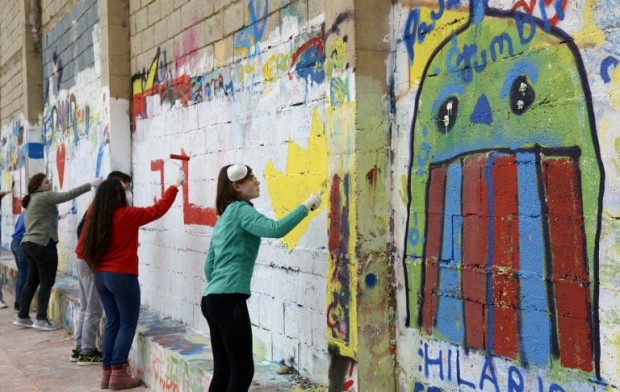Street art revives divided Spanish village

Youths paint a wall in the local sports centre during a visit to Fanzara near Castellon de la Plana, on December 15, 2016. Fanzara, a Spanish hamlet in the mountainside, nestled in the hinterland of Valencia has for years sufferred from local political quarrels. Recently a new breath of life has washed over the town thanks to urban artists from all over the world who have helped to heal its wounds. Photo from AFP.
FANZARA, Spain – Fanzara is a small Spanish country village whose handful of mostly elderly residents were once so bitterly divided that their allegiance to one camp or the other determined which bar they frequented.
So heated became the local tussle over plans to build a toxic waste dump that it aroused old Civil War-era rivalry and prompted neighbors to cross the street to avoid one another.
But, today in Fanzara, the bad blood is almost forgotten and the village has been revived — thanks to street artists from around the world.
Tourists now flock to admire giant murals created by invited urban artists on the sides of buildings in the village, which has become an open-air art gallery.
To the chimes of the village bell and dogs barking in the distance, Fanzara, some 80 kilometers (50 miles) north of the eastern port city of Valencia, has become a living canvas for colorful artwork.
Article continues after this advertisementA three-wall picture depicts a robot with long, thin arms chasing cats, while another nearby mural features a creature with large white eyes holding a tiny planet in its hand.
Article continues after this advertisement“We looked for an arts and culture project that everyone could take part in and that would re-establish good relations among villagers,” said former municipal councilor Javier Lopez, one of the project’s architects.
For years, residents of Fanzara – 70 percent of them pensioners — had been at loggerheads over the waste incinerator proposal.
It was defeated in the end and the right-wing municipal council promoting the project was swept from power in 2011 elections.
But locals say tensions remained long after the plan was dropped, with supporters drinking in the village’s “upper bar”, while opponents, who were concerned about the incinerator’s environmental impact, preferred the “lower bar”.
“We would know what side you were on depending on which bar you went to,” said Marc Zapata, a 22-year-old firefighter seated at a table in the “upper bar”.
The feud even stoked old divisions between left- and right-wing families dating back to Spain’s bloody 1936-39 Civil War.
Gain trust
So in 2014 the village’s new municipal council came up with the idea to invite local residents and street artists to create one giant mural.
It turned into a street art festival, with 21 artists descending on Fanzara a few months later who ended up decorating dozens of grey walls encouraged by enthusiastic locals. Some could be seen hoisted on cranes as they painted the walls.
Three years later, Fanzara’s annual festival, known as the Unfinished Museum of Urban Art (MIAU), has joined the circuit of street art events, including prestigious festivals in Copenhagen and New York.
Initially many villagers had been reluctant to hand over the wall space.
But the artists gradually gained their trust by working closely with them and designing works that reflect village life.
A Spanish visual artist, who goes by the name of Hombre Lopez, depicted residents’ faces on pebbles at a nearby river.
The mural of the robots chasing cats is near a small street, which has been taken over by stray felines.
“The original goal of mural art is just that: to reach people, take art out of museums,” says Lopez.
Seeing the change in people
Since 2015 more than 2,300 children have taken a guided tour of the works, helping to invigorate the life of the village that is home to just 18 schoolchildren.
Fanzara now has 105 works and many residents have embraced the festival. More than 200 artists from around the globe have already applied to take part in its next edition, from July 6 to 9.
“Life is good and peaceful here. There is a pharmacy, a doctor, a butcher’s shop, a bakery… and now with MIAU, it is international,” said resident Elisa Edo.
“You open up a lot with all these people who come from elsewhere” to look at the works, the 64-year-old added.
For the second edition of the festival in 2015, several locals even put up the visiting street artists in their homes under a programme dubbed “Adopt an Artist”.
“What I liked the most was seeing the change in people,” said Lopez.
The street art gallery still has some detractors, though.
“We have lost the intimacy that is typical of a village,” said Sara Martinez, 21, as she sat at the “upper bar”.
She complained that, during the festival, artists “paint until nightfall. We hear all the time the ‘bip bip ‘ of the cranes.”
Fanzara’s Socialist mayor Ana Romero said, however: “The village is better.”
“I think the opponents are a minority.”